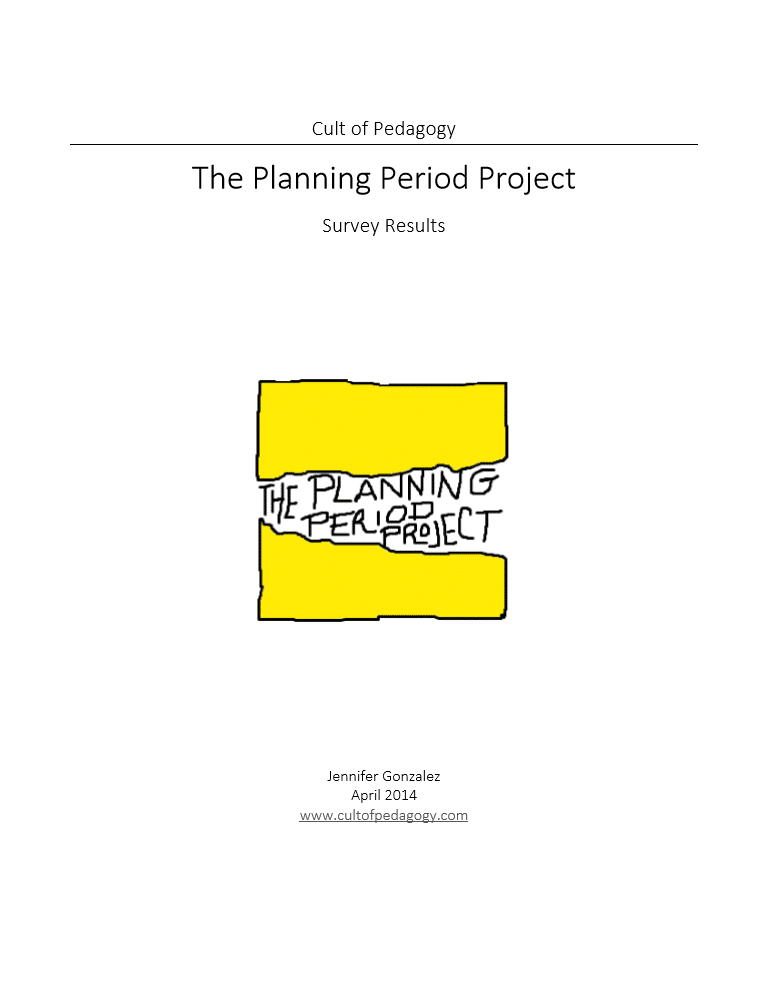
Planning time…
That little chunk of heaven built into your day to reflect on your practice, provide timely feedback on student work, collaborate with colleagues, pore over current research and best practices, and design just-right learning experiences to move your students forward.
It’s like that, right?
Not for most of you. And now we have numbers to back it up.
Last month, to get a better sense of how far we are from that fantasy, I launched the Planning Period Project, a 5-question survey designed to measure just how much planning time teachers actually get to use for planning and grading, what tasks take that time away, and how planning time impacts their job satisfaction. In one month, 300 responses were collected from teachers in 36 states. Though the results were pretty depressing, they confirm what most teachers in the U.S. already know:
You are absolutely starved for time.
Key Findings
Teachers are rarely allowed to use their full planning time to prepare instruction.
When asked what percentage of their planning time they got to use for grading and planning, nearly half said they got less than 20 percent of what they were supposed to get for that day. “My unstructured time each day is VERY LIMITED,” wrote one respondent, “yet they find ever-increasing ways to schedule this time for me, leaving diminishing time to grade and plan while giving me an increasing number of tasks and deadlines. It is frustrating — even dehumanizing — to have tasks and deadlines heaped on me while having the time I need to do them taken away.”
Twenty-five percent of respondents reported getting zero minutes of planning on the day they responded.
Although planning time during the school day is shrinking, the work itself isn’t going away. It was no surprise to find that more than half of respondents spent between 1 and 3 hours outside of the school day preparing to teach. “We get 35 minutes, four times a week for planning,” wrote one teacher. “However, by the time you walk the kids to their class and back, it looks a lot like 25 minutes. Very little can get done in 25 minutes four times a week. Most of my planning is done from 8 to 10 pm at home.”
Administrators have a LOT of control over lost planning time.
Respondents were asked to identify the tasks or activities that took their scheduled planning time away. A huge chunk of these — easily more than half — were activities that could be controlled or limited by an administrator: planned and unplanned meetings with staff or administration (35%), administrative tasks not directly related to instruction (18%), covering other teachers’ classes (5%), and “other” tasks (13%), which many respondents identified in their comments as the kind that administrators have the power to relieve them of, such as managing field trip paperwork, supervising students at lunch, and organizing testing materials.
Only 29 percent of lost planning time was attributed to direct contact with students or their parents.
There is a strong connection between planning time and job satisfaction.
Seventy percent of respondents said their job satisfaction was impacted “a great deal” by the amount of planning time they got. I added this question because there are so many issues being batted around in the education reform conversation, it made me wonder whether something as simple as sufficient planning time was still a concern. Lengthening and protecting planning time rarely gets more than a passing mention in discussions of ways to improve our work, but lack of time appears to be a significant factor in what’s pushing teachers out of the profession.
One new teacher describes it this way: “I spend more time “analyzing” data and filling in admin paperwork than I do planning, collaborating, and improving as a teacher COMBINED! I’m a second career teacher who joined the profession because thought I would be making a difference; 2 years into it and I am seriously reconsidering this choice!”
New initiatives certainly deserve some blame for lost planning time, but if we prioritized planning time the way we prioritized, say, running water in our buildings, then losing it would be a serious factor when implementing those initiatives. The impact that planning time has on teachers needs to be given more weight when any change is being considered.
The model is flawed to begin with.
The survey focused only on how much of their given planning time teachers actually got to use, but in the comments, many teachers shared the huge inadequacies in the planning time they were scheduled to have. Interruptions and other tasks notwithstanding, our planning time falls far short of what is needed — even on paper. Comment after comment portrayed tightly packed schedules with minimal prep time. Some teachers only get two planning sessions per week. One respondent, who took on an extra class this year, has no scheduled planning time at all.
But isn’t that just the nature of the job? Not everywhere. According to a 2010 research brief from Stanford University, U.S. teachers spend 80 percent of their work hours delivering instruction to students. The average in other high-achieving nations? 60 percent. And brace yourself: In South Korea, Japan and Singapore, that average plummets to a staggering 35 percent. Yes, you read that right. In these countries, just 35 percent of teachers’ time is spent teaching students. The rest of their work hours are spent collaborating, studying, and planning, making their instructional time as good as it can be.
It’s not that we don’t have the brain power here in the U.S. And it’s not that we don’t have the interest or the drive. We simply don’t have the time.
Where Do We Go From Here?
As was the case with our first survey, which examined how administrator behaviors impacted the teachers who work for them, this survey hopes to shine a light on an issue that isn’t getting enough attention. Budgets, reform, and policy issues aside, there are things that administrators and teachers can do right now to address this shortage — this famine of time we’re suffering from.
Study conditions in your school.
This was a small-scale survey, but its geographic distribution suggests that the problem is widespread. Still, every school is different. Studying teacher planning time in your school is a key step toward improving working conditions for your teachers. Administrators can spearhead a study, or if that isn’t happening, teachers can coordinate it themselves. Focus on determining what exactly is taking time away from planning, and look for patterns that could be addressed when creating solutions.
Take a close look at the grunt work.
Teachers reported a whole mess of things they were doing that took up time, tasks that have nothing to do with their training or expertise: managing paperwork for field trips, fundraisers, and school pictures; supervising students at lunch; processing data. This kind of work could easily be done by employees with less education and expertise.
Physicians don’t make appointment reminder calls or file patient insurance paperwork – they don’t even give injections. They are treated like professionals, and for the most part, the work that can be done by others is done by others. If we arranged things this way for teachers, even the meager planning time they currently have could be better utilized.
Your school may not have the budget to hire another teacher with a master’s degree, but what about an entry-level administrative assistant to handle some of those other tasks full-time? Or a temp who comes in several times a year to handle bigger projects? Your school may not be able to take all of these tasks out of teachers’ hands, but start by recognizing this work for the time-suck it is and always, always be looking for someone else to do it.
Get your house in order.
Malfunctioning printers, high teacher-to-copier ratios, and slow computers all waste planning time. Making sure your school has sufficient, well-maintained equipment could restore hours of time for instructional planning. Consider also whether other logistical changes might free up more minutes: One respondent wrote about having to walk a long distance every day to collect mail from the office. If your school has a group of teachers placed far from everyone else, why not set up a small office area at their end of campus and have one person deliver mail to them every day? Teachers can usually identify specific problems, then brainstorm creative solutions to create more time for everyone — if you’re an administrator, you just have to ask, and be willing to hear the answer. If your administrator isn’t the listening kind, strategize with other teachers to help each other get more time.
Find ways to cut back on meetings…and micromanaging.
“Meeting” and “paperwork” were the two hardest-working words in the comments section. Some of these are unavoidable in the short-term: If your state requires certain kinds of documentation, or certain meetings are mandated district-wide, then the only way to reduce these is through legislative channels.
But some documentation is about micromanaging your staff, and they know it. So think about ways the paperwork can be reduced.
By the same token, some meetings aren’t so necessary — maybe that weekly meeting would be more productive if it was held every other week. Others could be shorter if administrators can just be mindful of the time: Those extra ten minutes at the end of the faculty meeting, when you’re telling some story or going off on some tangent? Your staff is dying. Recognize that time is their scarcest commodity and LET. THEM. GO.
The work of a teacher is incredibly complex, and the behind-the-scenes work, if done well, takes at least as long as the time spent in active instruction. Although most educators, administrators, and policymakers will readily acknowledge this to be true, almost nothing has been done to give teachers that much-needed time.
Recognizing that we have a problem is a good first step. Short-term solutions like the ones proposed here can be next. But if we want real, lasting change, let’s start asking ourselves what it would take to get closer to the schedules they have in South Korea and Japan. If we really did have that little chunk of heaven, the fantasy of planning time come true, just imagine what a wonderful job this could be.
Download the full report here:






Working in a Title 1 district, where nearly all of the admin in the District Office wears multiple hats…I would be hard pressed to bring this up and get a positive response. I guess the best thing that I have done for myself if get super organized over summer, spent two weeks before even school even started making copies for two months worth of work, and come in at 7 every morning to get a full hour of planning. Once a week I plan with my grade level partner so that our weekends are free to do fun teacher stuff–like find this website! As a fairly new teacher I hear lots of complaining, and my district has it bad like others, but I still think there are ways to manage your time with what is given. Menial tasks can be split up among grade level teams, or even volunteers for non-sensitive information. Wonderful article thank you!
I’m amazed to hear you get planning time but completely understand how it quickly gets swallowed up. In New Zealand Primary (elementary) schools all planning is done outside of school hours
While I agree that planning is important, I think the numbers reflecting Japanese and Korean teachers time instructing are rather skewered. For one, they spend all their time at school even during school vacations, only having a few days which they can ” take off”. Outside of class however they have also club activities to oversee, so I don’t agree they have a lot of planning time, instead they have other tasks to do. Only during the school vacations do they have a lot of time, and even then much of it is taken up by overseeing club activities yet again. (I’m currently working as a teacher in japan myself)
Hi Anne. Thanks for sharing this information. It definitely helps round out our understanding of what teachers in other countries are expected to juggle.
Unfortunately, it seems that even those teachers ‘lucky’ enough to teach fewer hours are still drowning in other responsibilities, according to this article http://www.asahi.com/sp/ajw/articles/AJ201709130047.html